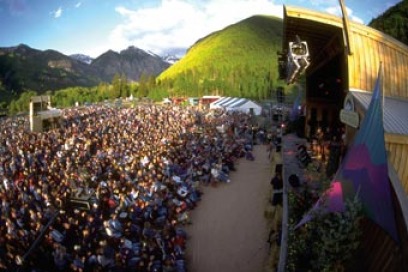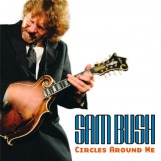Sam Bush: He pushed bluegrass to become newgrass
Published in Berkshire Eagle, 3/12/10

By Jeremy D. Goodwin
PITTSFIELD--Sam Bush is bringing it all back home.
Thirty-seven years after he helped forge a new musical genre with the trailblazing first album of signature band New Grass Revival, Bush is showing his roots.
A noted vocalist and mandolin player extraordinaire, Bush has made his name pushing the traditional boundaries of acoustic string music, in the process shaking up the stodgy bluegrass establishment with a new style—based on traditional mountain music, but informed by a fresh sensibility—that came to be named after his band.
“Lo and behold, all these years later, the word ‘newgrass’ has gotten to be like a generic term,” Bush reflects in a lively telephone interview from his home office in Nashville. “But I always say, if you wanna play newgrass, you have to know how to play bluegrass first.”
The Sam Bush Band’s new album, “Circles Around Me,” constitutes a plainer acknowledgment of Bush’s musical roots than he’s recorded in years. The band—including Byron House (bass), Chris Brown (drums), Stephen Mougin (guitar), and Scott Vestal (banjo)—is likely to showcase its new material when it plays the Colonial Theatre on North Street here on Saturday.
"You Left Me Alone"
from Circles Around Me (2009)

Though the folk, rock and jazz worlds had already experienced boundary re-defining explosions by the early 1970’s, bluegrass hung on as a tradition-ruled genre and scene with a conservative bent.
New Grass Revival shook things up on the traditional bluegrass circuit not only by incorporating electric instruments and songs by The Beatles and Bob Marley, but simply by eschewing the neat appearance and matching collared shirts still associated at the time with bluegrass.
Bush cites the improvisations of the Allman Brothers Band, Grateful Dead and Cream as early influences, plus the work of John Coltrane—heard via a collection of recordings released by Atlantic Records artists.
“We were taking influences outside of the bluegrass world and applying them to our instruments. It didn’t really seem at the time, and it still doesn’t seem to me like such an odd thing to do,” Bush says. “Yeah, we sort of broke the norm. Yeah, we had long hair, but so did everybody else who was college-aged back then. It was just outside of the box of that bluegrass festival scene that was going down. We colored outside the lines, I guess.”
Bush recalls warming up at traditional bluegrass festivals and hearing audience members remark that what New Grass Revival played wasn’t bluegrass. “Yeah, we know!” was the band’s response.
Coinciding with the band’s 17-year career (including the addition of a young Béla Fleck in 1981) was the grown of the summer festival circuit—festivals focusing on acoustic-based string music, as well as multi-genre festivals quick to welcome bands with bluegrass roots and rock and roll sensibilities. Telluride Bluegrass Festival, in its 37th year the leader in the field, provides a notably eclectic assemblage of acoustic-oriented artists. (Bush has been nicknamed the “King of Telluride.”)
New Grass Revival shook things up on the traditional bluegrass circuit not only by incorporating electric instruments and songs by The Beatles and Bob Marley, but simply by eschewing the neat appearance and matching collared shirts still associated at the time with bluegrass.
Bush cites the improvisations of the Allman Brothers Band, Grateful Dead and Cream as early influences, plus the work of John Coltrane—heard via a collection of recordings released by Atlantic Records artists.
“We were taking influences outside of the bluegrass world and applying them to our instruments. It didn’t really seem at the time, and it still doesn’t seem to me like such an odd thing to do,” Bush says. “Yeah, we sort of broke the norm. Yeah, we had long hair, but so did everybody else who was college-aged back then. It was just outside of the box of that bluegrass festival scene that was going down. We colored outside the lines, I guess.”
Bush recalls warming up at traditional bluegrass festivals and hearing audience members remark that what New Grass Revival played wasn’t bluegrass. “Yeah, we know!” was the band’s response.
Coinciding with the band’s 17-year career (including the addition of a young Béla Fleck in 1981) was the grown of the summer festival circuit—festivals focusing on acoustic-based string music, as well as multi-genre festivals quick to welcome bands with bluegrass roots and rock and roll sensibilities. Telluride Bluegrass Festival, in its 37th year the leader in the field, provides a notably eclectic assemblage of acoustic-oriented artists. (Bush has been nicknamed the “King of Telluride.”)

Telluride
Though the occasional movie soundtrack has, from time to time, brought traditional American music to the forefront—be it the use of “Foggy Mountain Breakdown” in “Bonnie and Clyde,” “Dueling Banjos” in “Deliverance,” or any number of songs in “Oh Brother, Where Art Thou?”--Bush credits the rise of the festival scene with exposing his work, both with New Grass Revival and as a solo artist, to wider audiences.
“One thing that appeals to the audience is this is not a trendy sort of way that we make our living. It’s not revolved around dance steps and television,” Bush says. “A lot of this kind of music is handed down. I am playing for an audience that is now including the grandchildren of people who once upon a time came to hear us and now they’re bringing their grandkids. That’s pretty great. That’s the way you not only keep an audience, but an audience continues to grow for this acoustic-style music.”
Though Bush’s signature style involves the incorporation of electric instruments and even a drummer—verboten in the land of traditional bluegrass—the latest album seems a celebration of the music that provides the bedrock for newgrass. It includes songs like “Midnight on the Stormy Deep,” associated with definitive versions performed by bluegrass godfather Bill Monroe, as well as two duets with legendary traditionalist Del McCoury. But it’s no historical re-creation. The album is fully informed by the evolution of newgrass. It even closes with a fresh version of “Whisper My Name,” a song dating back to the first New Grass Revival album.
“I wish I could say this was my big plan, but it felt right to do these songs together at this time,” Bush says. “I’ve got this great band that can play great acoustic bluegrass-style music if we want to. And I do love to mix acoustic and electric instruments and I will be doing that on stage when we’re in Pittsfield. But on this record I wanted to keep it all acoustic.”
Though he rejected “Full Circle” as an album title due to the term’s over-use, Bush acknowledges it would have been a good fit.
“Maybe, you spend a very long time out trying to prove your point with how progressive you can be, and all of a sudden it becomes a lot of fun to just relax and play bluegrass-style music—and newgrass.”
_______________________
Comment on this article!
“One thing that appeals to the audience is this is not a trendy sort of way that we make our living. It’s not revolved around dance steps and television,” Bush says. “A lot of this kind of music is handed down. I am playing for an audience that is now including the grandchildren of people who once upon a time came to hear us and now they’re bringing their grandkids. That’s pretty great. That’s the way you not only keep an audience, but an audience continues to grow for this acoustic-style music.”
Though Bush’s signature style involves the incorporation of electric instruments and even a drummer—verboten in the land of traditional bluegrass—the latest album seems a celebration of the music that provides the bedrock for newgrass. It includes songs like “Midnight on the Stormy Deep,” associated with definitive versions performed by bluegrass godfather Bill Monroe, as well as two duets with legendary traditionalist Del McCoury. But it’s no historical re-creation. The album is fully informed by the evolution of newgrass. It even closes with a fresh version of “Whisper My Name,” a song dating back to the first New Grass Revival album.
“I wish I could say this was my big plan, but it felt right to do these songs together at this time,” Bush says. “I’ve got this great band that can play great acoustic bluegrass-style music if we want to. And I do love to mix acoustic and electric instruments and I will be doing that on stage when we’re in Pittsfield. But on this record I wanted to keep it all acoustic.”
Though he rejected “Full Circle” as an album title due to the term’s over-use, Bush acknowledges it would have been a good fit.
“Maybe, you spend a very long time out trying to prove your point with how progressive you can be, and all of a sudden it becomes a lot of fun to just relax and play bluegrass-style music—and newgrass.”
_______________________
Comment on this article!


